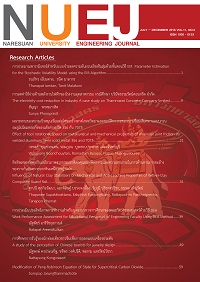Parameter Estimation for the Stochastic Volatility Model using the EM Algorithm
Main Article Content
Abstract
Article Details
References
Thailand Futures Exchange. [Online]. Available: http://www.tfex.co.th/th/products/set50futures-spec.html.
R. C. Merton, “The theory of rational option pricing,” Bell Journal of Economics, vol.4, pp.141-183, 1973.
F. Black, and M. Scholes, “The pricing of options and corporate liabilities,” Journal of Political Economics, 81, pp.637–654, 1973.
A. P. Dempster, N. M. Laird, and D. B. Rubin, “Maximum likelihood from incomplete data via EM algorithm,” Journal of the Royal Statistical Society, vol.39, no.1, pp.1-38, 1977.
B. D. O. Anderson, and J. B. Moore, Optimal Filtering, New York: Dover, 2005.
R. Faragher, “Understanding the basis of Kalman filter via a simple and intuitive derivation,” IEEE Signal Processing Magazine, pp 128–132, 2012.
M. Fridman, and L. Harris, “A maximum likelihood approach for non-Gaussian stochastic volatility models,” Journal of Business and Economics Statistics, vol.1, no.3, pp. 284-291, 1998.
F. J. Breidt, and A. L. Carriquiry, Improvement quasi maximum likelihood estimation for stochastic volatility models, New York: Springer, 1996, p.228-247.
S. J. Taylor, Financial returns modeled by the product of two stochastic processes–a study of daily sugar prices 1961–79. In Time Series Analysis: Theory and Practice, vol. 1. New York: Elsevier Science Publishing, p.203–226, 1982.
E. Ruiz, “Quasi-maximum likelihood estimation of stochastic volatility models,” Journal of Econometrics, vol.63, pp.289-306, 1994.
S. Chatterjee, Application of the Kalman filter for estimating continuous time term structure models-the case of UK and Germany, Department of Economics, University of Glasgow, 2005.
F. E. Racicot, and R. Theoret, “Forecasting stochastic volatility using the Kalman filter: An application to Canadian interest rates and price -earning ratio,” AESTI-MATIO, the IEB International Journal of Finance, vol.1, pp.28-47, 2010.
N. Shephard, and D. Xiu, Econometric analysis of multivariate realized QML: efficient positive semi-definite estimators of the covariation of equity prices, Department of Economics, University of Oxford, 2012.


